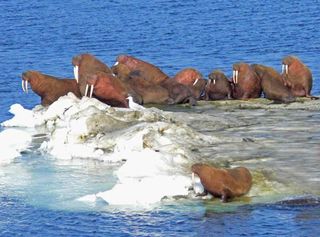
Freezing Bering Sea Once Balmy, Research Reveals

The Bering Sea, a frigid strip of ocean between Alaska and Russia, was once the much-warmer home to a rich diversity of life, new research suggests.
Deep sediment cores retrieved from the seafloor indicate that the region was ice-free year-round and very biologically productive during the Pliocene Warm Period, about 3.5 million to 4.5 million years ago.
"Evidence from the Pliocene Warm Period is relevant to studies of current climate change because it was the last time in our Earth's history when global temperatures were higher than today," said Christina Ravelo, a professor of ocean sciences at the University of California, Santa Cruz. Ravelo presented the new findings today (Dec. 13) in a talk at the 2010 fall meeting of the American Geophysical Union (AGU) in San Francisco.
Carbon dioxide levels during the Pliocene Warm Period were also comparable to levels today, and average temperatures were a few degrees higher, Ravelo said.
Climate scientists are interested in what this period may tell us about the effects of global warming, particularly in the polar regions. Current observations show more rapid warming in the Arctic compared to other places on Earth and compared to what was expected based on global climate models.
Ravelo's team found evidence of similar amplified warming at the poles during the Pliocene Warm Period. Analysis of the sediment samples indicated that average sea surface temperatures in the Bering Sea were at least 9 degrees Fahrenheit (5 degrees Celsius) warmer than today, while average global temperatures were only 5.4 degrees F (3 degrees C) warmer than today.
The samples, retrieved during a drilling expedition to the region last summer, showed evidence of consistently high biological productivity in the Bering Sea throughout the past five million years.
Sign up for the Live Science daily newsletter now
Get the world’s most fascinating discoveries delivered straight to your inbox.
In addition, samples from the Pliocene Warm Period include deep-water organisms that require more oxygenated conditions than exist today, suggesting that the mixing of water layers in the Bering Sea was greater than it is now, Ravelo said.
"We usually think of the ocean as being more stratified during warm periods, with less vertical movement in the water column," Ravelo said. "If the ocean was actually overturning more during a period when it was warmer than today, then we may need to change our thinking about ocean circulation."
Ravelo said her team's research reveals quite a lot about conditions on the planet during the last period of global warming.
"It should benefit the scientists today who are sorting out how ocean circulation and conditions at the poles change as the Earth warms," Ravelo said.
- Creatures of the Frozen Deep: Antarctica's Sea Life
- Infographic: Tallest Mountain to Deepest Ocean Trench
- In Images: Drilling Into the Seafloor
This article was provided by OurAmazingPlanet, a sister site to LiveScience.

